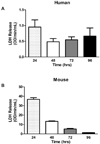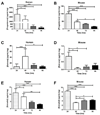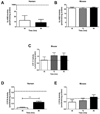Validation of murine and human placental explant cultures for use in sex steroid and phase II conjugation toxicology studies
- PMID: 25283089
- PMCID: PMC4251763
- DOI: 10.1016/j.tiv.2014.09.008
Validation of murine and human placental explant cultures for use in sex steroid and phase II conjugation toxicology studies
Abstract
Human primary placental explant culture is well established for cytokine signaling and toxicity, but has not been validated for steroidogenic or metabolic toxicology. The technique has never been investigated in the mouse. We characterized human and mouse placental explants for up to 96 h in culture. Explant viability (Lactate dehydrogenase) and sex steroid levels were measured in media using spectrophotometry and ELISA, respectively. Expression and activities of the steroidogenic (3β-hydroxysteroid dehydrogenase, Cytochrome P45017A1, Cytochrome P45019), conjugation (UDP-glucuronosyltransferase, sulfotransferase (SULT)), and regeneration (β-glucuronidase, arylsulfatase C (ASC)) enzymes were determined biochemically in tissues with fluorimetric and spectrophotometric assays, and western blot. Explants were viable up to 96 h, but progesterone, estrone, and 17β-estradiol secretion decreased. Steroidogenic enzyme expression and activities were stable in mouse explants and similar to levels in freshly isolated tissues, but were lower in human explants than in fresh tissue (P<0.01). Human and mouse explants exhibited significantly less conjugation after 96 h, SULT was not detected in the mouse, and neither explants had active ASC, although proteins were expressed. Mouse explants may be useful for steroid biochemistry and endocrine disruption studies, but not metabolic conjugation. In contrast, human explants may be useful for studying conjugation for <48 h, but not for steroid/endocrine studies.
Keywords: Conjugation; Ex vivo culture; Mouse; Placenta; Steroidogenesis.
Copyright © 2014 Elsevier Ltd. All rights reserved.
Figures






Similar articles
-
Blastomere removal from cleavage-stage mouse embryos alters steroid metabolism during pregnancy.Biol Reprod. 2012 Jul 5;87(1):4, 1-9. doi: 10.1095/biolreprod.111.097444. Print 2012 Jul. Biol Reprod. 2012. PMID: 22517623 Free PMC article.
-
Assisted reproduction technologies alter steroid delivery to the mouse fetus during pregnancy.J Steroid Biochem Mol Biol. 2011 Aug;126(1-2):26-34. doi: 10.1016/j.jsbmb.2010.12.012. Epub 2010 Dec 28. J Steroid Biochem Mol Biol. 2011. PMID: 21193037 Free PMC article.
-
Ex vivo and in vitro testis and ovary explants: utility for identifying steroid biosynthesis inhibitors and comparison to a Tier I screening battery.Toxicol Sci. 1998 Nov;46(1):61-74. doi: 10.1006/toxs.1998.2560. Toxicol Sci. 1998. PMID: 9928669
-
Placental steroid hormones.J Steroid Biochem. 1977 May;8(5):359-65. doi: 10.1016/0022-4731(77)90234-5. J Steroid Biochem. 1977. PMID: 340790 Review. No abstract available.
-
Assessment of steroidogenesis and steroidogenic enzyme functions.J Steroid Biochem Mol Biol. 2013 Sep;137:176-82. doi: 10.1016/j.jsbmb.2013.05.017. Epub 2013 Jun 13. J Steroid Biochem Mol Biol. 2013. PMID: 23770321 Review.
Cited by
-
Single-cell RNA sequencing reveals placental response under environmental stress.Nat Commun. 2024 Aug 2;15(1):6549. doi: 10.1038/s41467-024-50914-9. Nat Commun. 2024. PMID: 39095385 Free PMC article.
-
Identification of optimal conditions for human placental explant culture and extracellular vesicle release.iScience. 2023 Sep 26;26(10):108046. doi: 10.1016/j.isci.2023.108046. eCollection 2023 Oct 20. iScience. 2023. PMID: 37829201 Free PMC article.
-
Sex-specific effects of bisphenol A on the signaling pathway of ESRRG in the human placenta†.Biol Reprod. 2022 Jun 13;106(6):1278-1291. doi: 10.1093/biolre/ioac044. Biol Reprod. 2022. PMID: 35220427 Free PMC article.
-
Models of Endocrine-Disrupting Effects: Human Placental Steroidogenesis.Basic Clin Pharmacol Toxicol. 2025 Aug;137(2):e70073. doi: 10.1111/bcpt.70073. Basic Clin Pharmacol Toxicol. 2025. PMID: 40642781 Free PMC article. Review.
-
Blocking estrogen-induced AMH expression is crucial for normal follicle formation.Development. 2021 Mar 19;148(6):dev197459. doi: 10.1242/dev.197459. Development. 2021. PMID: 33658225 Free PMC article.
References
-
- Ahmed N, Murphy B. The effects of various hormones on human chorionic gonadotropin production in early and late placental explant cultures. American Journal of Obstetrics and Gynecology. 1988;159:1220–1227. - PubMed
-
- Begum-Hasan J, Senterman M, Gillett P, LaPlante Branchaud C, Murphy BE. Effect of maternal serum on viability and function of early human placental explants. In Vitro Cellular and Developmental Biology - Animals. 1993;29A:505–511. - PubMed
-
- Ben-Zimra M, Koler M, Melamed-Book N, Arensburg J, Payne AH, Orly J. Uterine and placental expression of steroidogenic genes during rodent pregnancy. Molecular and Cellular Endocrinology. 2002;187:223–231. - PubMed
-
- Benyo DF, Miles TM, Conrad KP. Hypoxia Stimulates Cytokine Production by Villous Explants from the Human Placenta. Journal of Clinical Endocrinology and Metabolism. 1997;82:1582–1588. - PubMed
-
- Carter AM. Animal models of human placentation - a review. Placenta. 2007;28(Supplement):S41–S47. - PubMed
Publication types
MeSH terms
Substances
Grants and funding
LinkOut - more resources
Full Text Sources
Other Literature Sources
Miscellaneous

